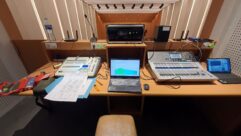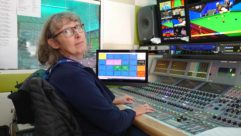Max Dighton has worked as a sound supervisor on many high-profile projects including BBC FA Cup, BT Sport Rugby, and ITV Football. He’s been an avid user of Calrec consoles for 10 years and worked as the sound supervisor on the annual BBC wildlife series Springwatch, which won a BAFTA Award.

- How did you get started in professional audio and what drew you to the field?
I started out as the stereotypical teenage guitarist in a band. My parents generously gave us a PA and from that point I was more interested in the mixing of the band than the playing. I studied Music Systems Engineering at UWE and as part of that degree, I spent a ‘Sandwich Year’ at the Tunbridge Wells Forum music venue mixing live bands five nights a week, which was a hugely beneficial experience. I ended up doing sound for lots of up-and-coming people, including Adele! I dabbled in some other jobs but 10 years later a friend who worked at Arena asked if I’d like to work in broadcast.
- We know you’ve been working as a freelancer for the past two years. Is Blanket Sound your company? In more detail, what does your current scope of work entail?
Blanket Sound is my company, so called as I ‘cover everything’. I work mainly as a Sound Supervisor but do also do some Sound Guaranteeing. Being freelance means that I do many different jobs every year/month/week. However, my regular Sound Supervising roles include: BBC FA Cup; BT Sport Rugby; BBC Cricket; ITV Football. The freedom of freelancing also means that I can do the occasional shift at the Tunbridge Wells Forum.
- What was it like working as the Sound Supervisor on the BBC2 series Springwatch? What was your role in the project?
It was fantastic to be given the opportunity to be Sound Supervisor in Louise Wilcox’s absence. I usually work as the Guarantee on Springwatch, and the ‘Watch’ family and I have learned a lot from Louise. It was great to be able to put that knowledge into action. As well as the live presentation elements – four presenters in three locations – there are live wild boxes/nests/areas. These are cut up during the show to highlight what’s going on in the wilderness of the UK.
The programme audio was from the satellite feeds. With the presenters being in different locations across the country and the satellite audio arriving at different delays, a ‘quick listen’ was fed into each presenter’s programme feed to help make conversations between them smooth and seamless. This was created by using AoIP, which arrived a lot earlier than the satellite audio. Being able to link faders instantly and send audio to so many different outputs made the whole process so easy.
- We know that Timeline TV and Cloudbass were both involved in that project too; can you explain what their roles were and how you all worked together?
Cloudbass supplied the wildlife coverage of the show. They were based in the Chew Valley, just south of Bristol, and had over 15 cameras each with audio fed to the Apollo desk in Timeline. Timeline supplied the gallery in Ealing and the uplink trucks in each presentation position. It was the first large remote production with which I’ve been involved – the delay page was used a lot during the three weeks of TX!
- We know that Springwatch 2020 won a BAFTA Award in the Live Event category; what was that experience like for you?
It was, and still is, very exciting to have been part of such an important show. It took place during lockdown, and I feel it really brought something uplifting into people’s homes at a very difficult time. At a personal level, it was great to still be able to play a part in creating the show and have a sense of normality at a time when live events had effectively been cancelled. We missed out on the specific Sound Craft BAFTA but to be nominated in such a strong category was an absolute honour.
- Can you describe a typical broadcast audio workflow that you use?
The workflow in an OB truck for me is very straightforward. Calrec Hydra2 networking boxes on the floor supply around 90 percent of the outside audio facilities hitting the desk. On some jobs, multis are still used but the simplicity of plugging into the Calrec makes the rig quick and simple.
In a remote situation in a studio gallery, the audio can arrive in several ways; for example, AoIP through many different manufacturers’ equipment or embedded satellite feeds. These are easily passed to the Calrec via AES/Dante/MADI and even analogue for backups.
- When did you first start working with Calrec products?
I started working with Calrec products when I joined Arena in 2011, which was my first time working in broadcast. With Calrec being so user-friendly and intuitive, I was able to use and Guarantee with them very quickly.
- What Calrec consoles have you used over the years and for what projects?
Omega: The earlier Arena OB trucks have Omega Bluefins in. I have used these extensively on sport and LE. It is the real workhorse of OBs.
Artemis: When OB11 was built at Arena we installed an Artemis. It continued the helpful user interface but with an updated look.
Apollo: The new OB workhorse was introduced to me when I joined NEP. More than just the ‘bigger Artemis’, it is an audio-mixing desk everyone wants to see when they turn up to a job.
Summa: Wimbledon use Summa desks for the outside courts, which I have been doing since 2019. One screen to rule them all; it’s so simple to stay in control.
Brio: I’ve used Brio desks a lot over the last year, both ‘plug and play’ and in an installed gallery. Working with Tall Audio we can rig a Brio and have it up and working in any location in a ridiculously short time. I used one in BT Tower as well as the old Dragons’ Den building in London. Timeline have a Brio in Ealing’s Gallery G, which I used for BBC Cricket Highlights last summer as well as many jobs in between.
- What’s a recent example of a project where you used Calrec technology?
With two channels simultaneously covering Channel 4 Paralympics, we linked an Apollo in Timeline’s UHD 2 and an Artemis in their new Ealing facilities. Linking them is straightforward and helps us to share facilities.
- What are the technological advantages of the Calrec console(s) that you’re using?
The hands-on operating system on all the consoles is definitely a standout feature. Touching one button leading you to everything you need means it’s all accessible immediately. Basically, the mix is easier with the knowledge that you can relax.
- What are your thoughts about AoIP and where the industry is at with it? What do you think it means for the future?
It’s vital. More broadcast is remote every week. Why have production onsite if they can all be together in a gallery close to home, particularly with the recent need to travel less.
- How do you see audio evolving in the next five years?
It’s already happening, but I can see it becoming the norm that supervisors mix from home.










